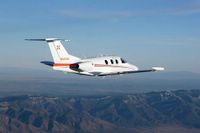Aerial Taxis About to Take Off
This describes the first commercial attempt at personal taxi model of jet travel. Whether this particular business will succeed remains to be seen. However, advances in low cost jets, fool-proof navigation and high air-traffic control will probably lead to more smaller jets rather than larger aircraft.Aerial taxis preparing for takeoff
Published: April 25, 2005, 4:00 AM PDT
By Michael Kanellos
Staff Writer, CNET News.com
A plan to shuttle commuters from city to city aboard five- and six-seater aerial taxis could be off the ground by next year.
Starting in mid-2006, DayJet (formerly Jetson Systems) plans to transport people between regional airports in the United States whenever passengers want. Need to get from Palo Alto in Northern California to Bakersfield in the southern part of the state and back the same day? For a moderate premium, DayJet, which calls itself a "per-seat, on-demand" air service, will do it.
The idea is to cater to business travelers who don't want to drive, but who also want to avoid the delays and stopovers that can plague jaunts between secondary cities on conventional airlines.
"This is a transportation system that adapts to your needs," said Ed Iacobucci, founder of software maker Citrix Systems and the man behind DayJet. "It is not about serving New York to Atlanta. It is more about serving the secondary and tertiary markets with a point-to-point network."
On-demand airlines have emerged as one of the buzzwords and potential opportunities in the field of aviation. Last month, at the Flight School conference in Scottsdale, Ariz., People Express founder Donald Burr discussed Pogo Jet, which will provide similar services, while Corporate Clipper will aggregate and book seats on these new types of airlines.
DayJet (and, to a similar degree, its competitors) hope to exploit two technological achievements--lightweight components and scheduling software--to bring down the cost of these type of flights to around 75 cents to $3 a mile, somewhat close to the cost of tickets on conventional airlines today.
The first technological breakthrough is a new type of light airplane that's comparatively inexpensive to manufacture and fly. The Eclipse 500, from Eclipse Aviation, for instance, can hit a maximum speed of 375 knots, carry five or six people (including pilots) and fly for about 300 to 600 miles.

Eclipse 500
The plane will sell for $1.3 million, less than conventional small planes, and weigh less, which cuts down on fuel costs. The advantages in weight and cost come in part from the use of semiconductors to replace many mechanical controls. The two Pratt & Whitney engines that power it measure only about 14 inches long and weigh less than most engines of their type. Microsoft Chairman Bill Gates is an investor in Eclipse.
DayJet has an order with Eclipse for 239 airplanes, with an option to buy 70 more. The planes will be delivered over a three-year period. The Federal Aviation Administration later this year may determine whether the Eclipse 500 and planes like it can be used for commercial flights. The second milestone lies in software for managing the flights. DayJet has hired Russian mathematicians from Citrix Systems to develop a reservation and scheduling system.
Even if it doesn't sell the other seats, DayJet won't raise the price or force the passenger to buy the unsold ticket.
But DayJet only needs to fill about 1.3 seats on each flight to break even, Iacobucci said.
Iacobucci wouldn't say where service would begin. He did say that within a 600- to 800-square-mile region, DayJet hopes to be able to fly into around 150 airports.
Aerial taxis preparing for takeoff | CNET News.com



1 Comments:
Dayjet will be a matter of time before it folds. Investors must be fools to lose money.
Post a Comment
<< Home